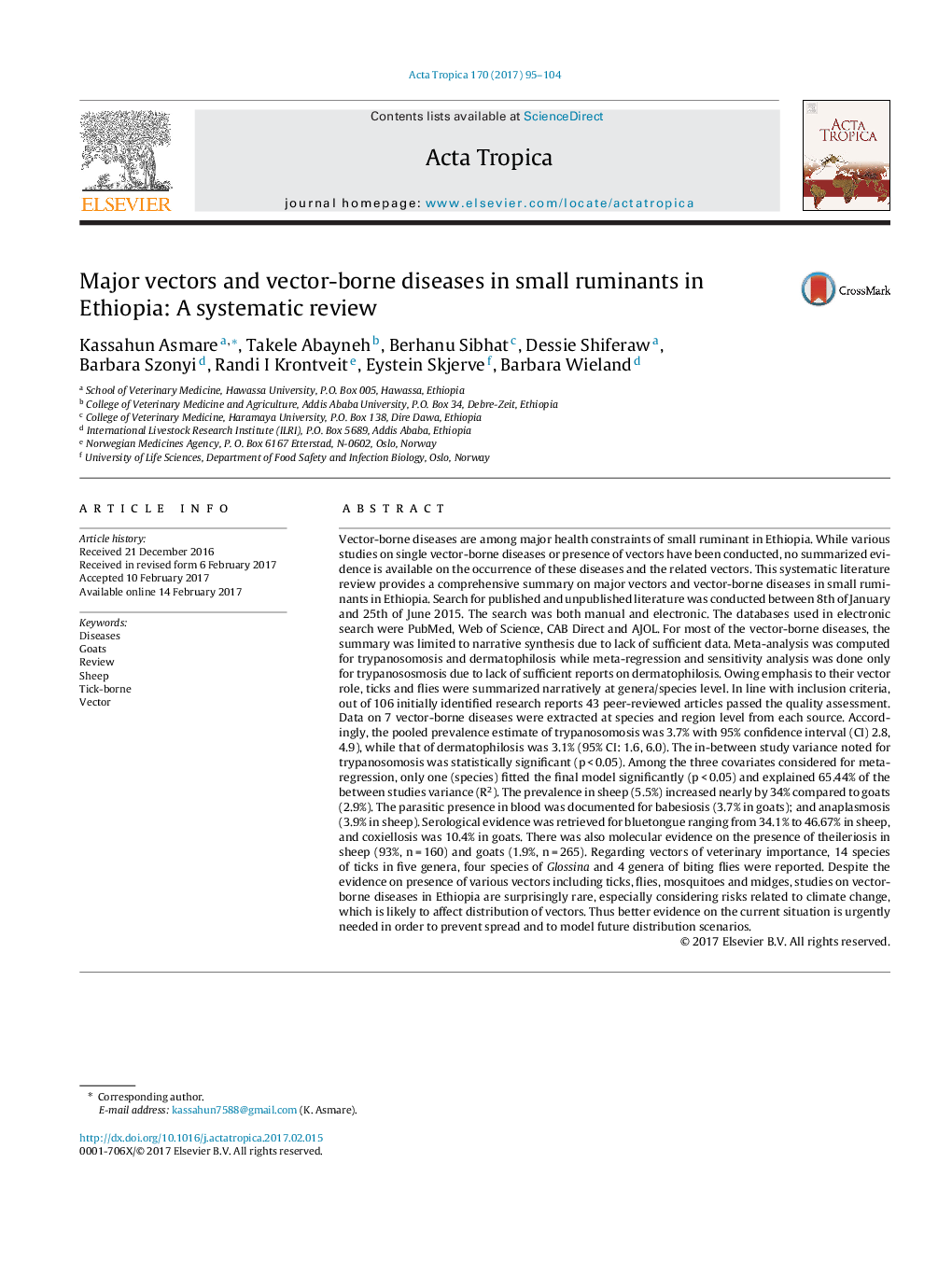| کد مقاله | کد نشریه | سال انتشار | مقاله انگلیسی | نسخه تمام متن |
|---|---|---|---|---|
| 5670787 | 1592754 | 2017 | 10 صفحه PDF | دانلود رایگان |
- The review identified seven vectorborne diseases of small ruminants in Ethiopia.
- Fourteen species of ticks were identified as important vectors of tick borne diseases.
- The pooled prevalence estimate of Trypanomosis in small ruminants was 3.7%,while that of dermatophilosis was 3.1%.
- Four species of Glossina and four genera of biting flies were identified as important vectors for trypanosomes.
Vector-borne diseases are among major health constraints of small ruminant in Ethiopia. While various studies on single vector-borne diseases or presence of vectors have been conducted, no summarized evidence is available on the occurrence of these diseases and the related vectors. This systematic literature review provides a comprehensive summary on major vectors and vector-borne diseases in small ruminants in Ethiopia. Search for published and unpublished literature was conducted between 8th of January and 25th of June 2015. The search was both manual and electronic. The databases used in electronic search were PubMed, Web of Science, CAB Direct and AJOL. For most of the vector-borne diseases, the summary was limited to narrative synthesis due to lack of sufficient data. Meta-analysis was computed for trypanosomosis and dermatophilosis while meta-regression and sensitivity analysis was done only for trypanososmosis due to lack of sufficient reports on dermatophilosis. Owing emphasis to their vector role, ticks and flies were summarized narratively at genera/species level. In line with inclusion criteria, out of 106 initially identified research reports 43 peer-reviewed articles passed the quality assessment. Data on 7 vector-borne diseases were extracted at species and region level from each source. Accordingly, the pooled prevalence estimate of trypanosomosis was 3.7% with 95% confidence interval (CI) 2.8, 4.9), while that of dermatophilosis was 3.1% (95% CI: 1.6, 6.0). The in-between study variance noted for trypanosomosis was statistically significant (p < 0.05). Among the three covariates considered for meta-regression, only one (species) fitted the final model significantly (p < 0.05) and explained 65.44% of the between studies variance (R2). The prevalence in sheep (5.5%) increased nearly by 34% compared to goats (2.9%). The parasitic presence in blood was documented for babesiosis (3.7% in goats); and anaplasmosis (3.9% in sheep). Serological evidence was retrieved for bluetongue ranging from 34.1% to 46.67% in sheep, and coxiellosis was 10.4% in goats. There was also molecular evidence on the presence of theileriosis in sheep (93%, n = 160) and goats (1.9%, n = 265). Regarding vectors of veterinary importance, 14 species of ticks in five genera, four species of Glossina and 4 genera of biting flies were reported. Despite the evidence on presence of various vectors including ticks, flies, mosquitoes and midges, studies on vector-borne diseases in Ethiopia are surprisingly rare, especially considering risks related to climate change, which is likely to affect distribution of vectors. Thus better evidence on the current situation is urgently needed in order to prevent spread and to model future distribution scenarios.
The flow diagram reveal how valid literatures were selected.116
Journal: Acta Tropica - Volume 170, June 2017, Pages 95-104
